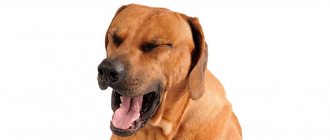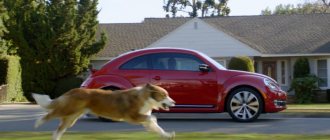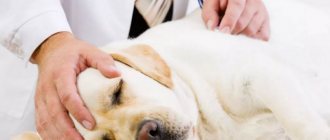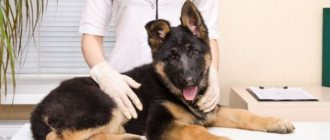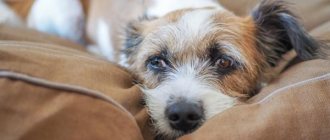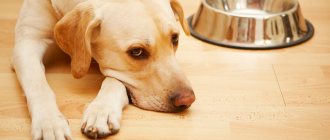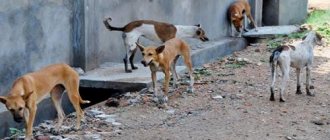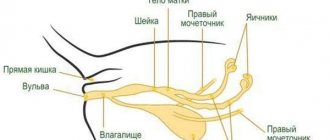How it all began
It all started with the fact that the claw on Jack’s hind paw began to peel off (the upper plate moved away from the core of the claw).
Jack wasn't bothered by this at all, so I cut off the peeling plate and decided to observe. After all, summer has begun, and Jack is an active guy: you never know what could happen during a walk.
Literally a few days after this, I noticed that some of the claws had changed: they darkened, something like spots appeared. All these changes happened very quickly.
And so, one morning, we, as usual, went for a walk to the bay. As always, Jack ran carefree over the rocks and swam... And we returned home cheerful and happy. But by lunchtime he began to press his paw. She turned red and was a little swollen. The base of the claw was bleeding, and the claw itself had turned a sickly burgundy hue.
Grabbing Jack in our arms, we rushed to the veterinarian. We made an appointment with the surgeon, being sure that Jack had simply injured his claw while walking.
After examining the paw and making sure the claw was intact, the surgeon referred us to a dermatologist. After examination and microscopic examination of material taken from the skin, the doctor made a diagnosis: “Lupoid onychodystrophy.”
So, what kind of disease is this?! What causes it, what are its symptoms, treatment and prognosis for a speedy recovery?
Signs that a dog has a broken nail
The injury received by an animal, as a rule, does not go unnoticed by attentive owners. The animal, which previously ran carefree during a walk or indoors, begins to limp. The dog tries not to step on the injured limb and keeps it suspended. Many individuals try to lick the painful area. Due to the fact that animal claws are equipped with blood vessels, their damage is most often accompanied by bleeding.
Upon visual inspection, the owner will find that the nail is either broken or completely torn out from the nail fold. The damage should be examined very carefully, as the slightest touch brings severe pain to the pet.
Symptoms
Lupoid onychodystrophy develops rapidly. In just 2-3 weeks, all the claws of the quadruped are damaged. One or two, or maybe several of the following symptoms of the disease may be observed:
- As a rule, it all starts with damage to one or two claws. The dog licks and chews the claw area.
- If a quadruped has light-colored claws, a change in color can clearly be seen on them: the appearance of spots, darkening or redness.
- The claws become brittle and brittle. Any mechanical impact instantly leads to damage. Just like us, pet owners associate this with common trauma. Lameness associated with pain appears.
- Claw damage occurs on all four limbs at once. That is why lupoid onychodystrophy in dogs is called symmetrical.
- The claw plate is torn away from the claw bed. The claws peel and crack. Traumatization of the claws can often cause the development of paronychia (inflammation of the periungual fold). Redness and swelling appear. The base of the diseased claw may bleed. Damaged paws hurt and itch.
- In some cases, a secondary bacterial infection and the appearance of pus may occur.
- Over time, the claws begin to fall out one by one. Overgrown claws are weak, brittle, discolored and deformed. If the disease is left to chance, the newly grown weak claws will fall out again and again.
Symmetrical lupoid onychodystrophy in dogs: photos of possible changes in the claws affected by this disease.
Lupoid onychodystrophy affects only the limbs, causing a lot of trouble and pain. Otherwise, if I may say so, sick dogs are quite healthy.
Causes of nail bed damage
The disease usually occurs for the following reasons:
- penetration of bacteria, viruses, fungi into the wound surface;
- when a claw breaks off as a result of injury;
- metabolic diseases accompanied by a lack of calcium and phosphorus, which are responsible for the strength of the stratum corneum of the claws;
- congenital anomalies;
- tumor processes.
According to veterinary experts, autoimmune pathologies often lead to felon in dogs.
We recommend reading about the treatment of boils in dogs. From the article you will learn about the reasons for the appearance of boils in dogs, signs on the head, nose, paws, consequences for the animal, prevention.
And here is more information about how to help a dog if it has damaged its claw.
Diagnosis
As a rule, a differential diagnosis is made first. This is a complete list of diseases with similar symptoms. In our case, it includes: the possible presence of fungal and bacterial infections, drug dermatitis, vasculitis and autoimmune diseases.
Then, after a series of examinations, we were given a final diagnosis: Lupoid onychodystrophy.
Why exactly this, and why, say, not a fungal infection or injury? Yes, because with injuries, the claw plate grows normally and the lesions will not be so generalized (spreading over all limbs). And a fungal infection does not cause rejection of the nail plate.
Well, the surest way to make a final diagnosis is histopathological examination of the material (amputation of the phalanx of the finger along with the claw). As a rule, owners of four-legged animals rarely give their consent to this type of research.
Treatment and prognosis for recovery
Treatment of lupoid onychodystrophy in dogs is individual in each specific case. The doctor looks at the condition of the four-legged patient and the severity of the disease.
The therapy is quite safe, but it takes a long time, since to assess the effectiveness of treatment it is necessary to check the growth of a healthy claw. And this takes several months.
What does treatment of the disease include:
- First of all, it is necessary to cut and file all peeled and deformed claws, as they cause pain to the pet when walking.
- New claws require special attention. To prevent further delamination and cracking, they should be promptly trimmed every 2 weeks, or as they grow.
Useful lifehack:
If you accidentally hit a blood vessel while trimming your nails, the bleeding can be stopped immediately. Simply cauterize the cut site with potassium permanganate powder (dry potassium permanganate) using a regular ear stick.
- The preferred treatment option is to take drugs such as Doxycycline, Pentoxifylline, as well as a diet enriched with PUFAs.
- Very often, treatment becomes effective with the help of daily intake of polyunsaturated fatty acids. Noticeable growth of claws is observed already 3 months after the start of treatment.
- If there is no improvement from taking fatty acids, vitamin E is prescribed. More aggressive methods are rarely prescribed. They involve taking drugs from the group of immunosuppressive drugs: Azathioprine, Cyclosporine.
- If a secondary bacterial infection is present, systemic antibiotics are prescribed.
If you contact a veterinary clinic in a timely manner and if all prescriptions are followed, the prognosis for the growth of healthy claws is quite good. After just 6 months, the claws are completely renewed, although some may remain deformed.
Claw diseases in dogs, their causes and treatment
Dogs are often exposed to various diseases. Nail disease in dogs is a serious problem because nails are an important tool for a dog to live a comfortable life.
When walking and running, the dog uses its claws to grip the ground. They help dogs hold objects in their paws. In addition, dogs dig the ground with their claws. Sometimes they are used as weapons.
Despite the fact that the role of claws in the daily life of domestic dogs is not as great as in wild animals, our pets often use them.
Causes
The causes of nail diseases in dogs can be very diverse. In some cases, situations arise when, with the same symptoms of a disease, its causes lie in completely different phenomena.
In general, the causes of diseases are:
- Infectious diseases. Their result is the appearance of inflammation, malnutrition, and subsequently the mechanical strength of the claws. They can be bacterial, viral or fungal.
- Traumatic injuries. This can be either blows or bruises, or mechanical damage, which consists of breaking off claws or unsuccessful attempts to trim them.
- Pathological changes in the endocrine system of the animal's body lead to metabolic disorders, which results in a deficiency in the body of calcium and phosphorus - elements necessary for the growth of horny formations.
- Autoimmune diseases.
- Various causes of congenital or hereditary nature.
- Neoplasms and tumors of various types.
Sometimes some reasons may consist of combinations of the above, or some may follow from others. For example, damaged claws are more likely to become infected with fungus.
The consequences of viral infections or their improper treatment can negatively affect the animal’s metabolism, which leads to a decrease in the amount of calcium in the body, and this, in turn, makes the claws brittle.
Symptoms
If the dog is healthy, then its claws are quite dense and elastic, they have a semicircular shape and their points are directed downward, and the color in most cases matches the color of the animal. Any deviation from these parameters can already be considered as a symptom of the disease.
Let's look at the symptoms for various situations:
Ingrown claw
Due to age-related changes, but more often due to an inactive lifestyle, dogs may experience discomfort from very long nails, which, as they grow, sometimes grow into their paw pads. Such behavior not only irritates the dog, but also causes infectious diseases due to dirt from the ground and floor getting into the wounds.
The main symptom of this disease is lameness in the animal, as well as its excessive interest in its limbs. Sometimes, instead of lameness, the dog uses not all four legs, but only three (without the leg where the problem occurs).
Breaking off
While walking, a dog suddenly begins to limp, stops and begins vigorously licking his injured leg. This means that the pet's claw has completely broken off or large cracks have appeared in it.
Bacterial infection
The nature of the damage can be very different: from peeling to partial or complete destruction. Swelling may be present in the fingers. The animal has a fever and is in a bad mood.
Treatment
Treatment of the diseases considered in dogs can be carried out both at home and on an outpatient basis: it depends on the condition of the animal. It is advisable to contact a veterinarian to clarify the diagnosis, receive detailed advice and a list of medications necessary for treatment.
At home
Treatment of simple cases and a rehabilitation period after possible surgery are provided.
If the injuries were not global in nature, did not cause complications and did not require specialized procedures or operations, then the dog can be treated at home.
As a rule, it consists of trimming overgrown claws, treating wounds or areas affected by infection with special compounds or ointments.
In the vast majority of cases, external effects of drugs are used. Dogs really do not like any foreign liquids or ointments on their bodies and lick them off. Therefore, after treatment, it is necessary to cover the limbs from the possibility of the pet licking them.
Drugs
When breaking off claws, use antiseptic solutions and lotions.
Treatment of crumb wounds due to bruises or ingrown claws is done using anti-inflammatory ointments (camphor, Konkova and others).
The following drugs are used to treat felon:
- Vishnevsky ointment;
- potassium permanganate powder;
- boric acid powder;
- a solution of dimexide in novocaine (in a ratio of 1 to 1) with the addition of tetracycline.
Treatment of bacterial infections requires the use of antibiotics, antiviral or antifungal drugs.
In the clinic
Clinical treatment is used in complex or advanced situations. These include:
- particularly severe cases of ingrown claws, when their penetration into the pulp causes large wounds and leads to infections;
- injuries in which the claw is completely broken off and the finger is damaged;
- infections on several fingers or even paws;
- the appearance of felon on several fingers;
- problems with the wolf's claw (if it was not removed at birth).
Many of these cases may require surgery, performed under local or general anesthesia. If the disease is at a late stage, it may even require amputation of fingers (with felon) or an entire limb (with felon of several fingers or especially dangerous forms of infectious lesions, when irreversible changes in the tissues occur).
Prevention
Any disease is easier to prevent than to cure. Prevention of any claw disease in dogs is a simple and not burdensome procedure. In this case, the following rules should be adhered to:
- Dogs should be walked in places where there is a hard surface: asphalt, concrete, rocky areas.
- At the end of each walk, you must thoroughly wash your pet's paws.
- After this hygiene procedure, the dog's paws should be examined to identify possible splinters and damage. It must be remembered that they may not appear immediately, but some time after receiving damage. Dogs have a fairly high pain threshold and this will affect the animal’s behavior after a certain time.
- Carry out regular nail inspections and trim them properly as needed.
- Monitor the animal’s diet: a balanced diet is the key to its health.
By following these simple steps, you can significantly reduce the likelihood of your pet developing claw diseases.
Treatment prescribed for Jack
The drugs prescribed to Jack are recommended for the treatment of lupoid onychodystrophy:
- Unidox (the same as Doxycycline).
- Pentoxifylline.
- Onsior for the treatment of inflammatory syndromes (in the case of Jack, his paws).
- Megaderm or Derm Liquid (vitamins - source of PUFAs).
- Shampoo with chlorhexidine (for the treatment and prevention of skin diseases).
Two weeks have passed since the start of our treatment. I can't say I see any obvious improvements with the claws. But the swelling of the paw has subsided, although the redness still remains. And the claw looks very painful.
This is the situation today.
Only two weeks have passed, and our poor tailed baby is already exhausted. Daily medication intake and paw treatment. The tips of the claws have already been trimmed once for preventive purposes. Jack has to walk around wearing a collar because he tries to lick and gnaw on that same painful claw.
When walking, and even at home, this big-booted little creature now has to be limited in everything (at least until the inflammatory process passes). Don’t dig holes, don’t run around with dogs as much as you can, don’t scatter the soil after peeing. In general, a dog's life...
Well, we told you what symmetrical lupoid onychodystrophy in dogs is, which we unexpectedly had to face. Treatment and recovery will be long. I will keep you updated on our progress.
When to help yourself, and when you can’t do without a veterinarian if your dog has damaged a claw
One of the common orthopedic injuries in four-legged friends is a broken claw. Damage is often accompanied by bleeding, pain and requires immediate intervention. An attentive owner should be able to provide first aid to a pet and know what measures will help prevent the problem.
The main causes of injuries on the front and hind legs
An active and agile dog can break a claw in a wide variety of situations - while chasing a cat or in a fight with relatives, or in an unsuccessful jump from a height. A common cause of injury is the tendency of many dogs to dig holes in hard ground and sand. Having caught on snags, bumped into hard objects with their paws, stones, bricks, the claws are the first to break and break.
Old animals are predisposed to orthopedic problems due to the development of dryness of not only the skin, but also the stratum corneum. Brittle and dry claws will break off sooner or later.
keeping pets in a dry room, especially in winter when central heating is on, is often accompanied by claw injury. As a rule, a dog’s extra claws are susceptible to the problem, since the support claws grind down naturally and do not stick out to the sides.
Veterinary experts believe that an unbalanced diet and the presence of diseases of the endocrine system and internal organs can lead to damage. Thus, with a deficiency of vitamin A, biotin, B vitamins, zinc, selenium, and iron, separation of the stratum corneum, dryness and brittleness of the nails are noted.
Dog “manicure” also suffers from diseases of the thyroid gland, disorders of mineral metabolism, and liver pathologies.
We recommend reading about how to stop bleeding in a dog. From the article you will learn how to stop stomach bleeding, bleeding from the mouth, nose, nails and uterus.
And here is more information about a broken paw in a dog.
Signs that a dog has a broken nail
The injury received by an animal, as a rule, does not go unnoticed by attentive owners. The animal, which previously ran carefree during a walk or indoors, begins to limp.
The dog tries not to step on the injured limb and keeps it suspended. Many individuals try to lick the painful area.
Due to the fact that animal claws are equipped with blood vessels, their damage is most often accompanied by bleeding.
Upon visual inspection, the owner will find that the nail is either broken or completely torn out from the nail fold. The damage should be examined very carefully, as the slightest touch brings severe pain to the pet.
First aid: what painkiller to give, how to treat
Having discovered an injury, the owner must competently provide first aid to his four-legged friend. If the damage is accompanied by bleeding, then first of all measures are taken to eliminate it. It is best to examine a restless individual with an assistant who will hold the dog firmly during manipulations.
First, you need to inspect the wound for the presence of foreign objects - glass and metal fragments, wood chips, splinters, thorns, sharp thorns, pine or spruce needles, plant seeds.
Bleeding from a damaged claw can be removed in several ways: using a hemostatic pencil, hydrogen peroxide, baby powder, potassium permanganate solution. To quickly stop bleeding, apply a pressure bandage or gauze.
The most crucial moment when providing first aid to an animal is removing a broken nail. If the injury occurred closer to the end of the horn formation, then you can break off the damaged area using special nail clippers. Use a nail clipper to remove the hanging fragment with a quick but confident movement.
As a rule, such manipulation is painful for the dog, but the pain is immediate. If the damage is located near the base of the claw, you should not carry out the manipulation yourself.
The owner's next step should be to prevent infection of the open injury by infectious factors. A feature of the anatomical structure of the claw is its connection with the bone structures of the limb.
Therefore, it is important to prevent dirt from getting into the wound. To this end, the owner must carry out antiseptic treatment of the damaged area.
This can be done with the help of antibacterial compounds - Miramistin, Chlorhexidine solution, Furacilin.
If you have a special iodine-based wound remedy in your medicine cabinet - Monclavit - then its simple and convenient use will facilitate antiseptic treatment.
If possible, the open injury can be sprinkled with streptocide powder. If you have an anti-inflammatory ointment on hand, for example, Levomikol, Tetracycline, then you can also use a creamy form of antiseptic. The paw should be placed in a clean cotton sock or bandaged to prevent the wound from becoming infected.
Contacting a veterinarian for a claw injury
Considering the complex structure of the claws, their proximity to bone formations, the risk of infection and the development of inflammation of surrounding tissues, after first aid is provided, the animal must be taken to a specialized institution. Qualified help is necessary for incessant bleeding, severe lameness that does not go away over time.
You should also contact a veterinarian if the claw is damaged in close proximity to the paw.
During the examination, the doctor will first clean the wound and perform an antiseptic treatment. If the pain is severe, the animal will be sedated to remove the broken claw.
The manipulation is carried out with a special surgical instrument, which allows you to quickly and without dissecting the stratum corneum to trim the damaged claw.
Then the bleeding is stopped and an aseptic bandage is applied to the paw.
Broken Claw
Orthopedic trauma in an animal is associated with severe pain. In some cases, a veterinarian uses painkillers - Baralgin, Spazgan - to reduce the pet's suffering.
After claw removal
If there is a threat of penetration of pathogenic microorganisms into deep tissues, the furry patient is prescribed a course of antibacterial drugs. For preventive purposes, antibiotics with a wide spectrum of action are used - Baytril, Cobactan, Cefatoxime.
Recommendations for further treatment of the wound surface depend on the degree of damage. As a rule, care consists of applying an anti-inflammatory ointment to the wound, for example, Levomycetin, Ichthyol, Vishnevsky's liniment.
The animal should be given complete rest and the duration of walks should be reduced. To speed up wound healing, a veterinarian may recommend enriching your pet’s diet with vitamins A and E, biotin, selenium, zinc, and sulfur using multivitamin and mineral supplements.
To see what can happen if you don’t remove a dog’s broken claw, watch this video:
Prevention of nail damage in dogs
Considering the prevalence of the problem, orthopedic veterinarians and experienced dog breeders recommend that owners of four-legged friends adhere to the following rules for care and maintenance:
- Trim overgrown nails regularly. The overgrown stratum corneum clings to hard surfaces and sooner or later will lead to injury. Neglecting this simple hygiene procedure will protect your dog from painful injuries.
- The manipulation should be carried out using a special tool for trimming animals. The nail clipper should be made of high-quality metal, which will prevent the occurrence of hangnails and delaminations when trimming the nail. Particular attention should be paid to additional claws, which, due to their physiological characteristics, grow faster.
- The animal's diet must be balanced in nutrients, vitamins and microelements.
- In winter, when keeping dogs in heated rooms, it is recommended to humidify the air using an air conditioning system and sprayers.
We recommend reading about eye injury in dogs. From the article you will learn about the causes of eye injuries in dogs, types of injuries, diagnosis of the condition of the cornea and other parts of the eye, and treatment.
And here is more information about how to treat a dog’s wound.
A broken claw can cause serious problems for your four-legged friend in the form of bleeding and pain. The owner’s task is to be able to competently provide first aid to the animal and deliver it to the clinic as soon as possible. An examination by a veterinarian is necessary if there is bleeding from the wound, severe lameness and pain.
Treatment consists of complete or partial removal of the damaged nail, stopping bleeding and antiseptic treatment of the wound.
To learn how to properly trim a dog's nails, watch this video:
Source: https://zootvet.ru/sobaka-povredila-kogot/


